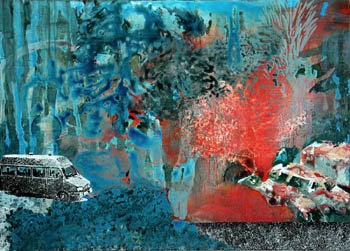Canon
dal 12/10/2006 al 17/11/2006
Segnalato da
Ina Bierstedt
Geraldine Gliubislavich
Katie Heck
Hideko Inoue
Arif Ozacka
Gines Parra
Barry Reigate
Ken Pratt
12/10/2006
Canon
The Agency Gallery, London
Ina Bierstedt, Geraldine Gliubislavich, Katie Heck, Hideko Inoue, Arif Ozacka, Gines Parra, Barry Reigate. A group exhibition of emerging international painters who engage in a renewed reflection on modernism and will centre around an original Gines Parra from 1932, part of the Spanish School of Paris.

Ina Bierstedt, Geraldine Gliubislavich ,Katie Heck,Hideko Inoue, Arif Ozacka, Gines Parra, Barry Reigate
curated by Ken Pratt
The Agency is pleased to present Canon, a group exhibition of emerging international painters who engage in a renewed reflection on modernism and will centre around an original Gines Parra from 1932, part of the Spanish School of Paris. Canon includes painters who work from European perspectives as well as those culturally rooted outside the European iconography. The shifting context that has once again “allowed" the re-emergence of painting as craft is part of a broader realization that, in the digital age, the discussions that once informed conceptual practice and thoughts about representation are fully assimilated into mainstream practice and less pressing than they were 15 years ago. Freed from the imperative to engage with photography, film and the other digital means of producing images now so widely available that their use is no longer sufficient to constitute an artistic action in and of itself, artists are free to return to researching other means of constructing arresting images. And unsurprisingly, the new generation of painters will often look to the modernist languages that arose in the twentieth century to progress their painterly languages.
In another sense, the exhibition hopes to prompt a secondary recognition that European modernist painting languages have always had an intrinsic reflective gaze that foregrounds explorations of that which is outside the everyday reference, whether in terms of culture or states of consciousness. The inclusion of a work by neglected Spanish modernist, Gines Parra from 1932 is used a keynote to this consideration. Gines Parra was a contemporary of Picasso and a member of the Spanish enclave of the School of Paris. In his work, perhaps informed by his experiences of living in Africa and South America, or perhaps merely as an adherent to the modernist concerns with “primitive art", he uses form and colour in a mid-twentieth century painting language alluding to visual elements of cultures beyond its native Europe.
In the work of the contemporary painters the play with iconography and reproduction takes on a more complex form. Having the whole of the Twentieth century canon at their disposal, the works are as likely to reference early modernism, such as social realism as they are the later permutations of modernism such as Cobra, outsiders like Philip Guston through to early post-modernism such as Kippenberger. As a result Canon presents as much the tensions of progressive modernism as it reflects the movement as a whole from a 21st century viewpoint.
Bierstedt (former East Germany) and Gliubislavich ( Rumania) both refer to modernist painting as return to order ,in that they both utilise references to 20th century painting in an affirmative way. Bierstedt layers acrylic over oil, like Richter first did but the representation is of a symbolic order with an underlying unease, Gliubislavich looks to mass scenes as represented in social realism, yet imbues them with the spirit of 19th century symbolism. Hideko Inoue (Japan) looks to European social realism, which took its root in Japanese painting at a later stage and introduces the thematic treatment of photographic realism in painting with a nod to the digital age, which in its beginning was synonymous with Japanese technology. Arif Ozakca, (London/Turkey) mixes the traditions of post-modern painting by juxtaposing quotations of Carravagiesque bodies with authentic Persian miniatures in order to highlight the relevance of identity in the global age with the iconography of old masters. Barry Reigate(GB) is indebted to the painterly exuberance of Guston and adding to it graffiti and the very British “Monthy Python" graphics. The works reference fantasy graphics and yet clearly also contain social critique and a dark edge. German Born Kati Heck mixes traditional composition with childlike drawing and text references to cabaret and hedonism of an era much quoted yet gone. Her work draws the show full circle with its clear reference to the Burlesque. Gines Parra’s piece from 1932 reinforces this with its joyful representation of a picnic scene with nudes painted in thick impasto.
Canon celebrates the freedom painters have finally achieved to reference across international and historical boundaries and allows the viewer to enjoy the complex and multi-layered approaches modernism sought out to progress towards by rebelling against the conventions of the latterday. Being reversly rebellious all recent works have in common their expert technique and despite clear references are provocative and reveal the renewed energy of painting as a medium.
An in-depth essay by Ken Pratt will be available soon
The Agency Gallery
15 A Cremer Street -London



